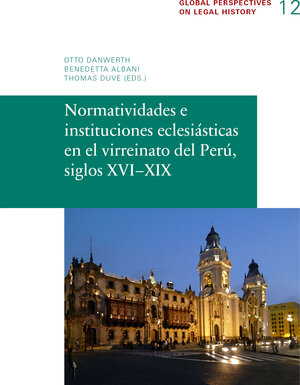
×
![Buchcover ISBN 9783944773230]()
Normatividades e instituciones eclesiásticas en el virreinato del Perú, siglos XVI–XIX
herausgegeben von Otto Danwerth, Benedetta Albani und Thomas DuveEcclesiastical institutions and actors played key roles in the formation of normative orders in early modern Ibero-America. However, both legal historiography, due to its strong legalistic, state-centered imprint, and general historiography on colonial times, more inclined towards secular law, have only rarely discussed the contribution of ecclesiastical normativity to the formation of that normative texture which has been called ‘derecho indiano’.
In light of that situation, the Max Planck Institute for European Legal History organized a series of seminars in different Latin American cities in order to offer an interdisciplinary forum dedicated to the research of ecclesiastical normativities and institutions in Ibero-America between the 16th and 19th centuries. The present volume (in Spanish) is the second in a series of publications that document the – peer reviewed – results of this cycle of seminars held in Mexico City, Lima, Bogotá, and São Paulo.
From its foundation in 1543 and until the 18th century, the Viceroyalty of Peru covered nearly the entirety of Spanish South America: from Panama to Chile, with the exception of Venezuela. This book does not aim to offer an exhaustive investigation, but its eight case studies do analyze significant ecclesiastical institutions and their normativities in locations of the viceroyalties of Peru and of Río de la Plata between the 16th and the early 19th centuries. The settings, today located in the nation states of Peru, Bolivia, Argentina, and Chile, belonged to the archdiocese of Lima and that of La Plata/Charcas.
The first section of the volume presents two articles on the ecclesiastic legislation produced by Toribio de Mogrovejo, the second Archbishop of Lima, at the end of the 16th century. The second part examines litigation in canon law and looks at the role of lawyers and procurators at the Audiencia Arzobispal de Lima (17th century). In the third section, religious orders are analyzed in two studies: a comparison of Jesuit missionaries in Austria and in Peru (late 16th century), as well as the case of the Monasterio de la Concepción in Lima until the middle of the 17th century. The fourth part discusses aspects of diocesan administration in outlying zones of the archdiocese of La Plata during the 18th century, focusing on ecclesiastical judges in Santa Fe and on the government of the bishopric of Córdoba del Tucumán. The fifth and final section deals with the ius patronatus in Chile during the independence movement in the early 19th century.
The studies on ecclesiastical institutions and normativities in various urban and rural locations of the vast Peruvian viceroyalty collected in this volume propose new research fields for legal history and the history of the Church, which at the same time are relevant for social and cultural history. The editors’ purpose has been to present approaches that explore the relationship between different types of normativities, their local adaptations, and their links with global debates, as well as to examine different forms of conflict resolution and the role of jurists, theologians, and other actors. The topics discussed in this volume contribute to a better understanding of the normative religious universe in Spanish America.
In light of that situation, the Max Planck Institute for European Legal History organized a series of seminars in different Latin American cities in order to offer an interdisciplinary forum dedicated to the research of ecclesiastical normativities and institutions in Ibero-America between the 16th and 19th centuries. The present volume (in Spanish) is the second in a series of publications that document the – peer reviewed – results of this cycle of seminars held in Mexico City, Lima, Bogotá, and São Paulo.
From its foundation in 1543 and until the 18th century, the Viceroyalty of Peru covered nearly the entirety of Spanish South America: from Panama to Chile, with the exception of Venezuela. This book does not aim to offer an exhaustive investigation, but its eight case studies do analyze significant ecclesiastical institutions and their normativities in locations of the viceroyalties of Peru and of Río de la Plata between the 16th and the early 19th centuries. The settings, today located in the nation states of Peru, Bolivia, Argentina, and Chile, belonged to the archdiocese of Lima and that of La Plata/Charcas.
The first section of the volume presents two articles on the ecclesiastic legislation produced by Toribio de Mogrovejo, the second Archbishop of Lima, at the end of the 16th century. The second part examines litigation in canon law and looks at the role of lawyers and procurators at the Audiencia Arzobispal de Lima (17th century). In the third section, religious orders are analyzed in two studies: a comparison of Jesuit missionaries in Austria and in Peru (late 16th century), as well as the case of the Monasterio de la Concepción in Lima until the middle of the 17th century. The fourth part discusses aspects of diocesan administration in outlying zones of the archdiocese of La Plata during the 18th century, focusing on ecclesiastical judges in Santa Fe and on the government of the bishopric of Córdoba del Tucumán. The fifth and final section deals with the ius patronatus in Chile during the independence movement in the early 19th century.
The studies on ecclesiastical institutions and normativities in various urban and rural locations of the vast Peruvian viceroyalty collected in this volume propose new research fields for legal history and the history of the Church, which at the same time are relevant for social and cultural history. The editors’ purpose has been to present approaches that explore the relationship between different types of normativities, their local adaptations, and their links with global debates, as well as to examine different forms of conflict resolution and the role of jurists, theologians, and other actors. The topics discussed in this volume contribute to a better understanding of the normative religious universe in Spanish America.



